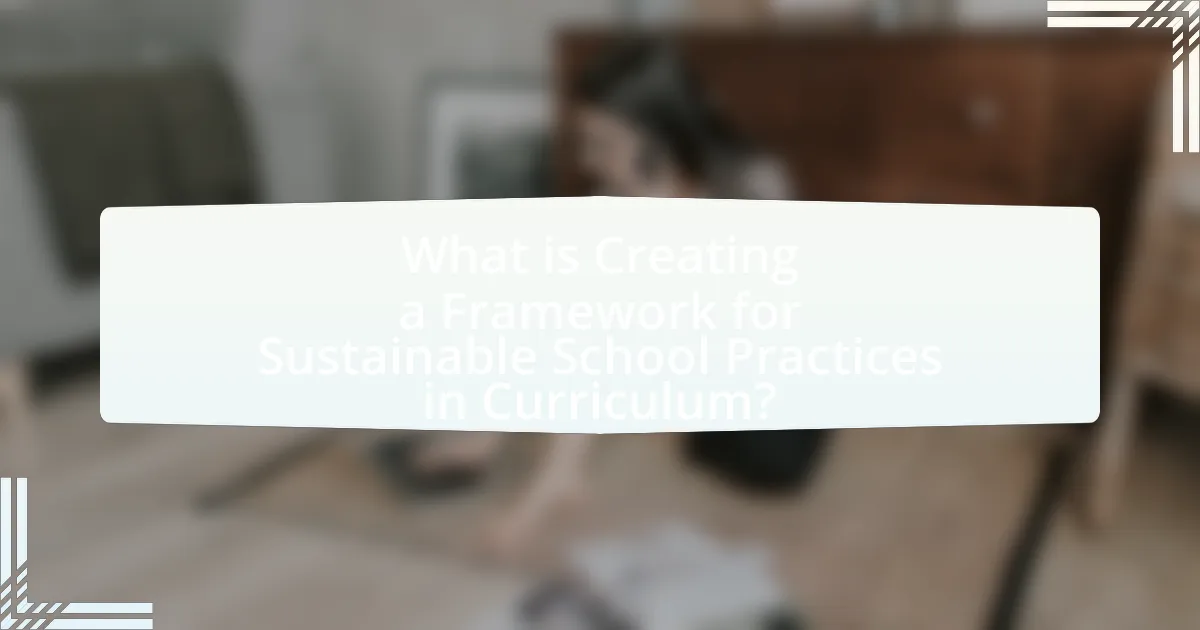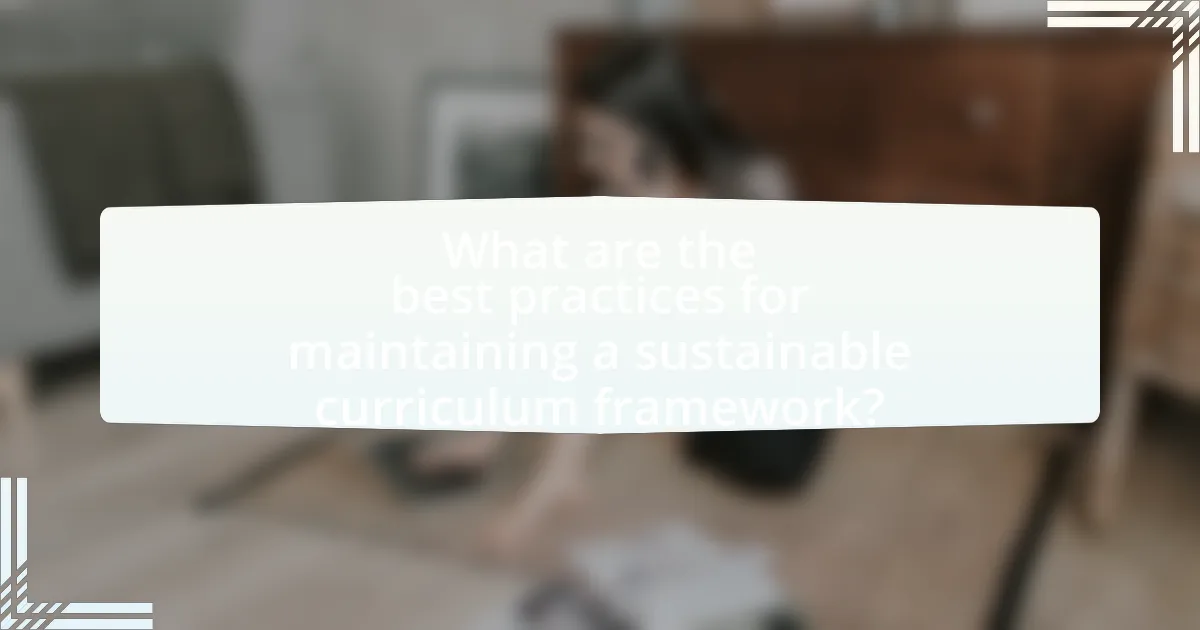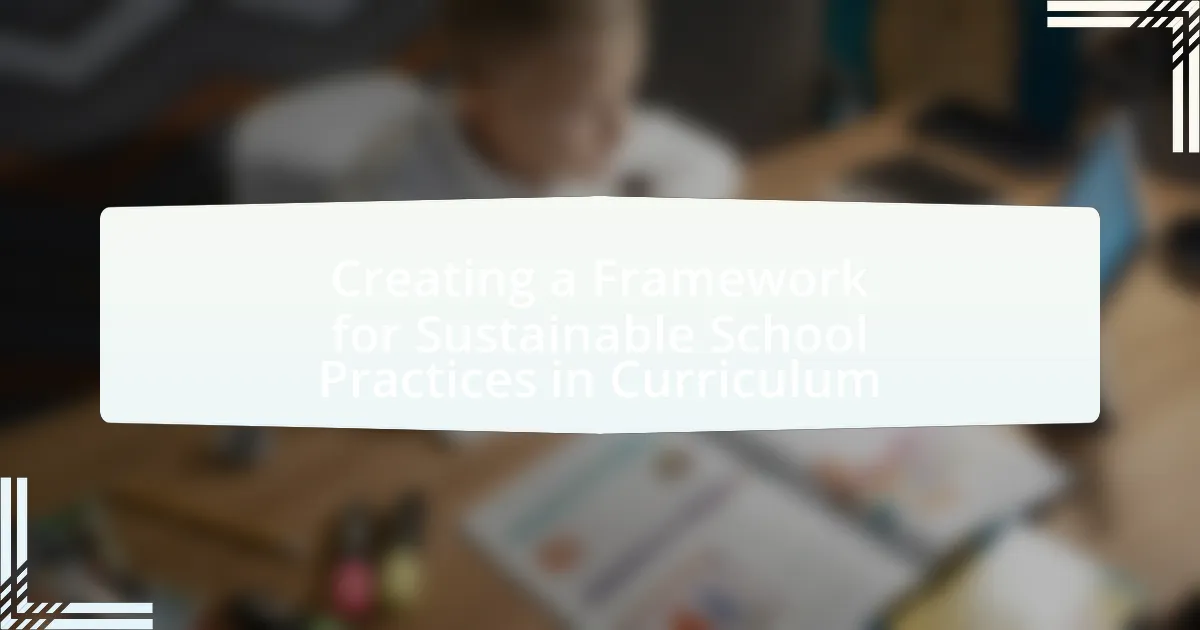Creating a framework for sustainable school practices in curriculum involves establishing structured guidelines that incorporate sustainability principles into educational programs. This framework aims to enhance environmental stewardship, social responsibility, and economic viability, ultimately preparing students to address global challenges. Key components include interdisciplinary learning, community engagement, and continuous assessment, which collectively foster critical thinking and problem-solving skills. The article also explores the importance of sustainability in curricula, the challenges schools face in implementation, and strategies for integrating real-world sustainability challenges into teaching practices. Additionally, it highlights the role of funding, community involvement, and professional development in supporting sustainable education initiatives.

What is Creating a Framework for Sustainable School Practices in Curriculum?
Creating a framework for sustainable school practices in curriculum involves developing structured guidelines that integrate sustainability principles into educational programs. This framework aims to promote environmental stewardship, social responsibility, and economic viability within the school curriculum. Research indicates that incorporating sustainability into education enhances students’ awareness and engagement with global challenges, fostering critical thinking and problem-solving skills essential for future generations. For instance, the United Nations Educational, Scientific and Cultural Organization (UNESCO) emphasizes the importance of education for sustainable development, highlighting that curricula should empower learners to contribute to sustainable societies.
Why is sustainability important in school curricula?
Sustainability is important in school curricula because it equips students with the knowledge and skills necessary to address environmental challenges. Integrating sustainability into education fosters critical thinking and encourages responsible citizenship, preparing students to make informed decisions about resource use and environmental stewardship. Research indicates that educational programs focused on sustainability can lead to increased awareness and behavioral changes regarding environmental issues, as seen in studies conducted by the National Environmental Education Foundation, which found that students exposed to sustainability concepts are more likely to engage in eco-friendly practices.
What are the key principles of sustainability in education?
The key principles of sustainability in education include holistic learning, interdisciplinary approaches, community engagement, and fostering critical thinking. Holistic learning emphasizes the interconnectedness of social, economic, and environmental systems, encouraging students to understand the broader implications of their actions. Interdisciplinary approaches integrate various subjects, allowing students to explore sustainability from multiple perspectives, such as science, ethics, and economics. Community engagement involves collaboration with local stakeholders to address real-world sustainability challenges, enhancing the relevance of education. Fostering critical thinking equips students with the skills to analyze complex issues and develop innovative solutions, essential for addressing future sustainability challenges. These principles are supported by educational frameworks like the United Nations Sustainable Development Goals, which advocate for quality education that promotes sustainable practices.
How does sustainability impact student learning outcomes?
Sustainability positively impacts student learning outcomes by fostering critical thinking, engagement, and real-world problem-solving skills. Research indicates that when sustainability is integrated into the curriculum, students demonstrate improved academic performance and a deeper understanding of complex systems. For instance, a study published in the Journal of Environmental Education Research found that students involved in sustainability-focused projects scored higher on assessments related to environmental science and social studies, highlighting the effectiveness of experiential learning in enhancing educational outcomes.
What are the components of a sustainable school curriculum framework?
A sustainable school curriculum framework consists of several key components: interdisciplinary learning, community engagement, environmental education, social equity, and continuous assessment. Interdisciplinary learning integrates various subjects to provide a holistic understanding of sustainability issues. Community engagement involves collaboration with local organizations and stakeholders to enhance real-world relevance. Environmental education focuses on ecological literacy, teaching students about ecosystems and conservation. Social equity ensures that all students have access to quality education and resources, promoting inclusivity. Continuous assessment evaluates the effectiveness of the curriculum and allows for ongoing improvements based on feedback and changing needs. These components collectively support the development of responsible, informed citizens capable of addressing sustainability challenges.
What subjects should be included in a sustainable curriculum?
A sustainable curriculum should include subjects such as environmental science, social justice, economics, and sustainable agriculture. Environmental science provides foundational knowledge about ecosystems and biodiversity, which is essential for understanding sustainability. Social justice addresses equity and ethical considerations in sustainability efforts, ensuring that diverse perspectives are included. Economics teaches the principles of sustainable development and resource management, highlighting the balance between economic growth and environmental protection. Sustainable agriculture focuses on practices that promote food security while minimizing environmental impact. These subjects collectively equip students with the knowledge and skills necessary to address complex sustainability challenges.
How can interdisciplinary approaches enhance sustainability in education?
Interdisciplinary approaches enhance sustainability in education by integrating diverse perspectives and knowledge systems, which fosters a holistic understanding of environmental issues. This integration allows students to connect concepts from various disciplines, such as science, social studies, and economics, leading to more comprehensive solutions for sustainability challenges. For instance, a study by the National Academy of Sciences highlights that interdisciplinary education promotes critical thinking and problem-solving skills, essential for addressing complex sustainability issues. By engaging in projects that require collaboration across disciplines, students develop a deeper appreciation for the interconnectedness of ecological, social, and economic factors, ultimately preparing them to contribute effectively to sustainable practices in their communities.
How can schools implement sustainable practices in their curricula?
Schools can implement sustainable practices in their curricula by integrating environmental education across subjects, promoting hands-on projects, and fostering community partnerships. This approach allows students to engage with sustainability concepts in a practical context, enhancing their understanding and commitment to environmental stewardship. For instance, incorporating topics like renewable energy, waste reduction, and biodiversity into science and social studies classes can provide a comprehensive view of sustainability. Additionally, projects such as school gardens or recycling programs can offer experiential learning opportunities. Research indicates that schools that adopt such practices not only improve student engagement but also contribute to a culture of sustainability within the community, as evidenced by the “Green Schools” initiative, which has shown positive outcomes in student awareness and behavior regarding environmental issues.
What strategies can educators use to integrate sustainability into lesson plans?
Educators can integrate sustainability into lesson plans by incorporating project-based learning that focuses on real-world environmental issues. This approach allows students to engage in hands-on projects, such as creating a school garden or conducting energy audits, which fosters critical thinking and problem-solving skills related to sustainability. Research indicates that project-based learning enhances student engagement and retention of knowledge, making it an effective strategy for teaching sustainability concepts. Additionally, integrating interdisciplinary themes, such as climate change, renewable energy, and conservation, across subjects can help students understand the interconnectedness of these issues. This method aligns with educational standards and promotes a holistic understanding of sustainability.
How can schools measure the effectiveness of their sustainable practices?
Schools can measure the effectiveness of their sustainable practices through quantitative metrics such as energy consumption reduction, waste diversion rates, and water usage efficiency. For instance, tracking energy bills before and after implementing energy-efficient systems can provide clear data on savings, while waste audits can quantify the amount of recyclable materials diverted from landfills. Additionally, surveys assessing student and staff engagement in sustainability initiatives can offer qualitative insights into the cultural impact of these practices. Research indicates that schools implementing comprehensive sustainability programs see an average reduction of 20-30% in energy costs, demonstrating the tangible benefits of such measures.

What challenges do schools face in creating a sustainable curriculum?
Schools face several challenges in creating a sustainable curriculum, primarily including limited funding, lack of teacher training, and insufficient resources. Limited funding restricts the ability to implement innovative programs and acquire necessary materials for sustainability education. Additionally, many educators lack training in sustainability concepts, which hampers their ability to effectively teach these principles. Insufficient resources, such as access to up-to-date technology and materials, further complicate the integration of sustainability into the curriculum. These challenges collectively hinder the development of a comprehensive and effective sustainable curriculum in schools.
What are common barriers to implementing sustainable practices in schools?
Common barriers to implementing sustainable practices in schools include limited funding, lack of administrative support, insufficient training for staff, and resistance to change among stakeholders. Limited funding restricts the ability to invest in necessary resources and infrastructure for sustainability initiatives. Lack of administrative support can hinder the prioritization of sustainability within the school’s agenda, making it difficult to allocate time and resources effectively. Insufficient training for staff results in a lack of knowledge and skills needed to implement sustainable practices, while resistance to change among stakeholders, including parents and community members, can create obstacles to adopting new practices. These barriers collectively impede the successful integration of sustainability into school curricula and operations.
How can schools overcome resistance to change among staff and students?
Schools can overcome resistance to change among staff and students by fostering a culture of open communication and involving all stakeholders in the change process. Engaging staff and students in discussions about the reasons for change and the benefits it brings can reduce anxiety and build support. Research indicates that when educators feel included in decision-making, their commitment to implementing changes increases significantly. For instance, a study by Fullan (2007) highlights that collaborative approaches to change lead to higher levels of buy-in and successful implementation in educational settings. Additionally, providing professional development and resources can equip staff with the skills needed to adapt, further easing resistance.
What role does funding play in developing sustainable curricula?
Funding is crucial in developing sustainable curricula as it provides the necessary resources for research, training, and implementation of innovative educational practices. Adequate financial support enables schools to invest in materials, technology, and professional development that align with sustainability goals. For instance, a study by the National Education Association highlights that schools with dedicated funding for sustainability initiatives report improved student engagement and environmental literacy. Thus, funding directly influences the effectiveness and reach of sustainable curricula, ensuring that educational institutions can adapt and thrive in a changing ecological landscape.
How can community involvement support sustainable school practices?
Community involvement can significantly support sustainable school practices by fostering collaboration between schools and local stakeholders, which enhances resource sharing and educational outreach. Engaging parents, local businesses, and community organizations can lead to the implementation of programs that promote environmental stewardship, such as recycling initiatives and community gardens. For instance, a study by the National Education Association found that schools with strong community partnerships reported a 20% increase in student participation in sustainability programs. This collaboration not only enriches the curriculum but also instills a sense of responsibility and awareness among students regarding sustainability issues.
What partnerships can schools form to enhance sustainability efforts?
Schools can form partnerships with local governments, environmental organizations, and businesses to enhance sustainability efforts. Collaborating with local governments can provide schools access to resources and funding for sustainability projects, such as recycling programs and energy-efficient upgrades. Partnering with environmental organizations can offer educational resources and expertise in implementing sustainable practices, such as habitat restoration and conservation initiatives. Additionally, businesses can support schools through sponsorships, donations, or by providing internships that focus on sustainability, thereby fostering a culture of environmental responsibility among students. These partnerships have been shown to improve community engagement and increase the effectiveness of sustainability initiatives in educational settings.
How can parents and local organizations contribute to sustainable education?
Parents and local organizations can contribute to sustainable education by actively participating in curriculum development and supporting environmental initiatives within schools. Parents can advocate for the inclusion of sustainability topics in the curriculum, ensuring that students learn about environmental stewardship and sustainable practices. Local organizations can provide resources, expertise, and funding for sustainability projects, such as school gardens or recycling programs. Research indicates that schools with strong community involvement in sustainability efforts see improved student engagement and learning outcomes, highlighting the effectiveness of collaboration between parents and local organizations in fostering sustainable education.

What are the best practices for maintaining a sustainable curriculum framework?
The best practices for maintaining a sustainable curriculum framework include continuous stakeholder engagement, regular curriculum evaluation, and integration of sustainability principles across subjects. Continuous stakeholder engagement ensures that educators, students, and the community contribute to curriculum development, fostering relevance and support. Regular curriculum evaluation, based on data-driven assessments, allows for timely updates and improvements, ensuring the curriculum remains effective and aligned with educational standards. Integrating sustainability principles across subjects promotes interdisciplinary learning and prepares students to address real-world challenges, as evidenced by studies showing that holistic approaches enhance student engagement and retention of knowledge.
How can schools ensure continuous improvement in their sustainability efforts?
Schools can ensure continuous improvement in their sustainability efforts by implementing a structured framework that includes regular assessments, stakeholder engagement, and integration of sustainability into the curriculum. Regular assessments allow schools to evaluate their current practices and identify areas for improvement, while engaging stakeholders—such as students, parents, and community members—fosters a collaborative approach to sustainability initiatives. Furthermore, integrating sustainability into the curriculum not only educates students about environmental issues but also encourages them to participate in sustainability efforts actively. Research indicates that schools that adopt such comprehensive frameworks see measurable improvements in their sustainability outcomes, as evidenced by the “Sustainable Schools: A Framework for Action” report by the U.S. Environmental Protection Agency, which highlights successful case studies of schools enhancing their sustainability practices through structured approaches.
What role does professional development play in sustaining educational practices?
Professional development is essential for sustaining educational practices as it equips educators with the latest pedagogical strategies and knowledge. Continuous training and learning opportunities enable teachers to adapt to evolving educational standards and student needs, thereby enhancing instructional quality. Research indicates that schools with robust professional development programs see improved student outcomes; for instance, a study by the National Staff Development Council found that effective professional development can lead to a 21% increase in student achievement. This evidence underscores the critical role of professional development in maintaining and improving educational practices over time.
How can schools adapt their curricula to evolving sustainability standards?
Schools can adapt their curricula to evolving sustainability standards by integrating interdisciplinary approaches that emphasize environmental education, practical sustainability practices, and community engagement. This adaptation can include incorporating topics such as climate change, renewable energy, and sustainable agriculture into existing subjects like science, social studies, and economics.
For instance, the National Environmental Education Foundation highlights that schools can implement project-based learning where students engage in real-world sustainability projects, fostering critical thinking and problem-solving skills. Additionally, aligning with frameworks like the United Nations Sustainable Development Goals can provide a structured approach for schools to ensure their curricula remain relevant and impactful.
Research indicates that schools that adopt such integrative methods not only enhance student awareness of sustainability issues but also promote a culture of environmental stewardship within the community, ultimately leading to more sustainable practices in the long term.
What practical tips can schools follow to enhance sustainability in their curricula?
Schools can enhance sustainability in their curricula by integrating environmental education across subjects. This approach allows students to understand the interconnectedness of ecological issues with various disciplines, such as science, social studies, and economics. For instance, incorporating project-based learning that focuses on local environmental challenges can engage students in real-world problem-solving. Research indicates that experiential learning, such as school gardens or recycling programs, significantly increases student awareness and commitment to sustainability practices. A study by the National Wildlife Federation found that schools implementing such programs reported a 30% increase in student engagement in sustainability initiatives.
How can educators incorporate real-world sustainability challenges into their teaching?
Educators can incorporate real-world sustainability challenges into their teaching by integrating project-based learning that focuses on local environmental issues. This approach allows students to engage with tangible problems, such as waste management or energy conservation, fostering critical thinking and problem-solving skills. Research shows that project-based learning enhances student engagement and retention of knowledge, as evidenced by a study published in the Journal of Educational Psychology, which found that students involved in hands-on projects demonstrated a 30% increase in understanding complex concepts compared to traditional teaching methods. By aligning curriculum objectives with real-world sustainability challenges, educators can create meaningful learning experiences that prepare students to address pressing environmental issues.
What resources are available for schools to support sustainable curriculum development?
Schools can access various resources to support sustainable curriculum development, including educational frameworks, professional development programs, and partnerships with environmental organizations. Notable frameworks such as the United Nations Sustainable Development Goals (SDGs) provide guidelines for integrating sustainability into curricula. Professional development programs, like those offered by the National Science Teachers Association, equip educators with strategies for teaching sustainability effectively. Additionally, partnerships with organizations such as EcoSchools and the Green Schools Alliance offer resources, training, and support for implementing sustainable practices in educational settings. These resources collectively enhance the capacity of schools to develop and implement sustainable curricula.

Leave a Reply